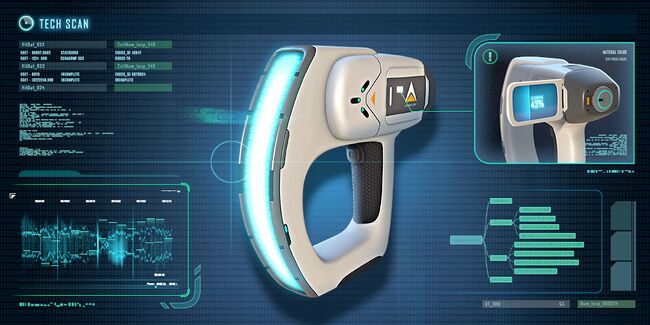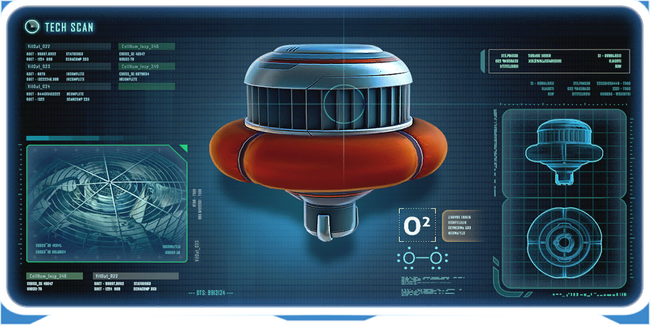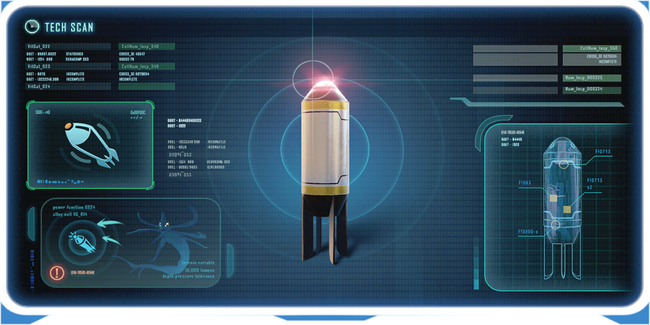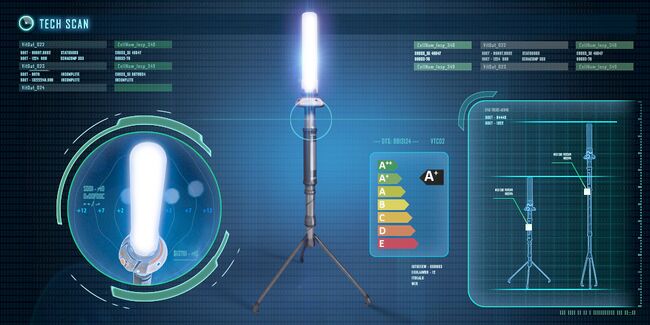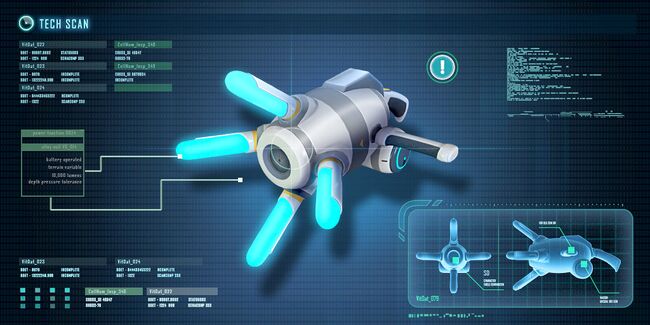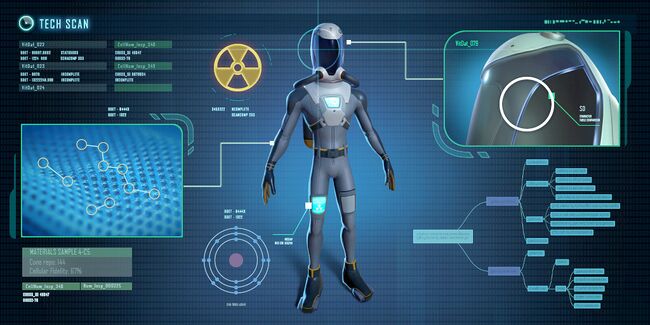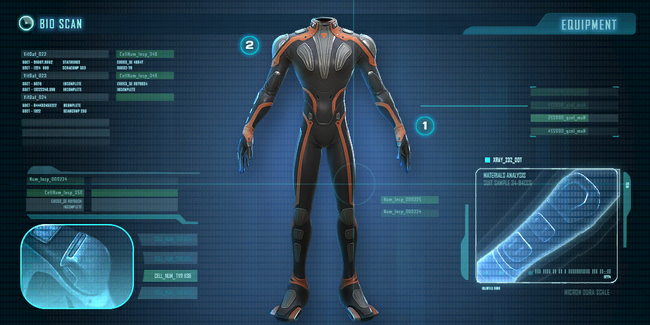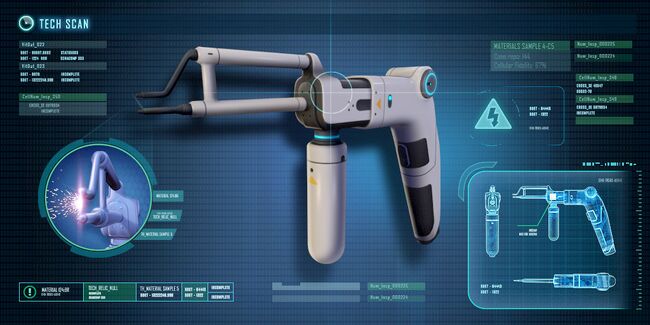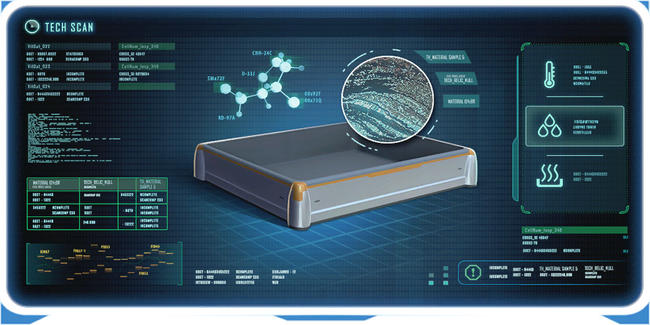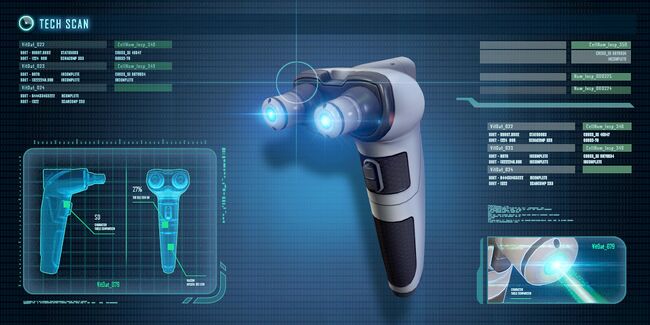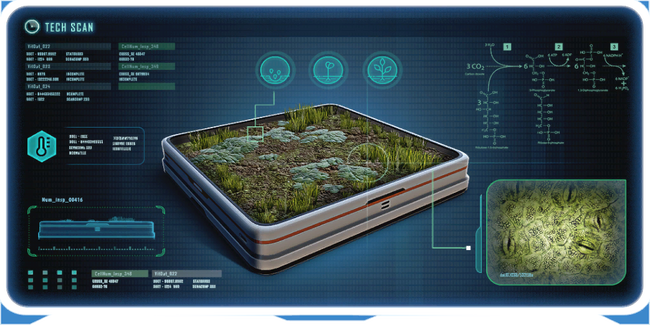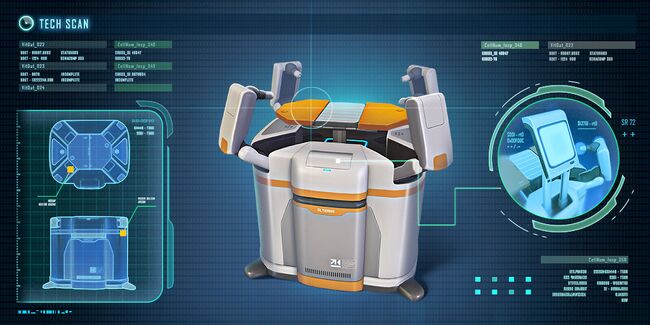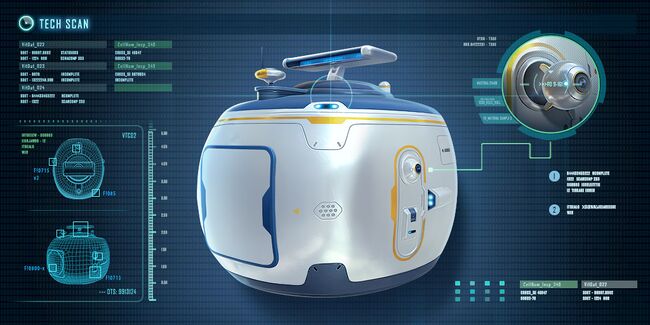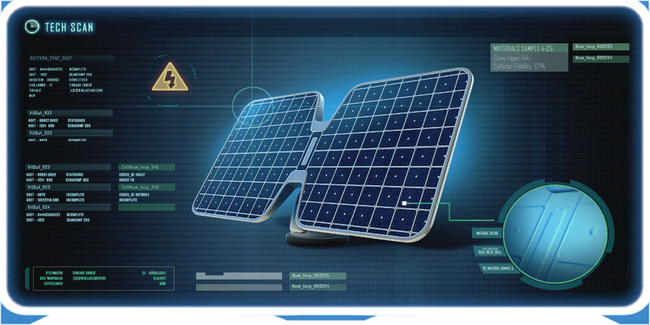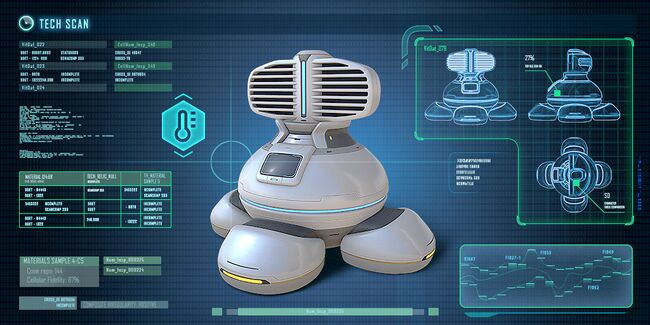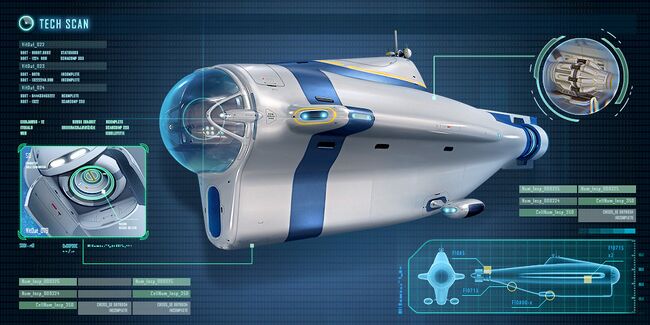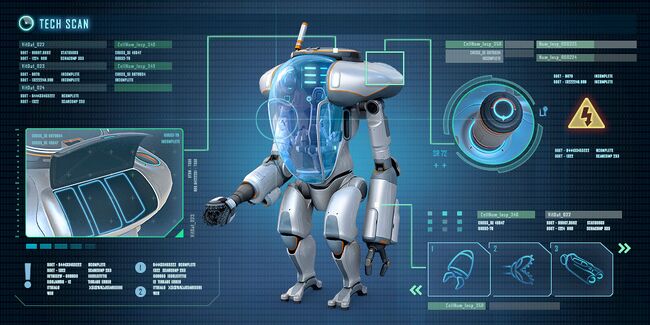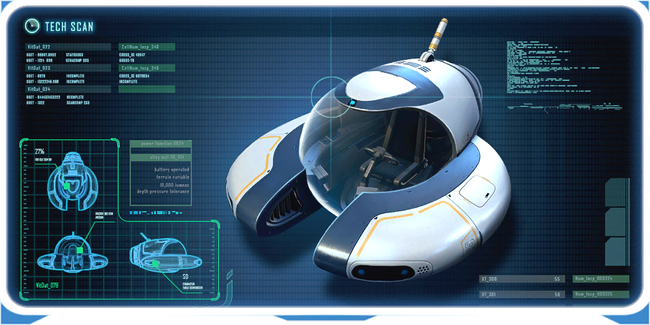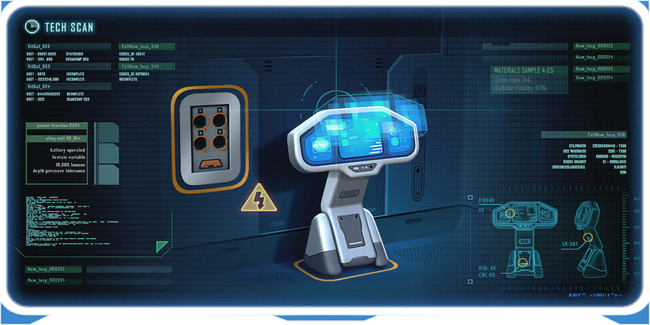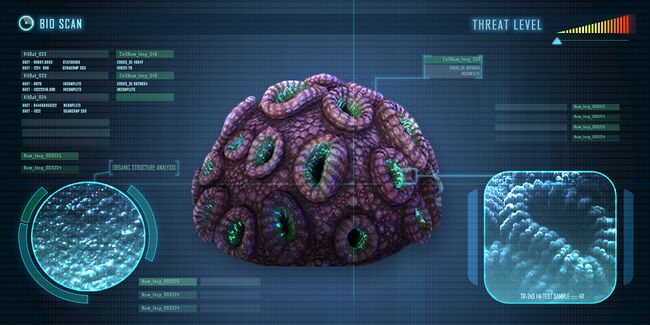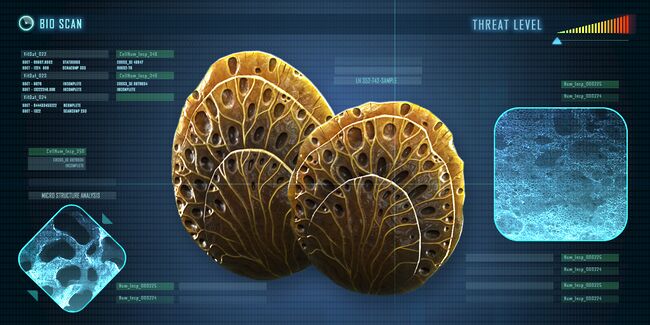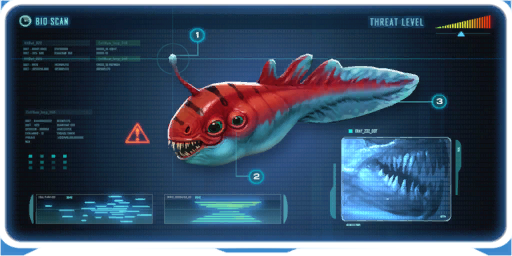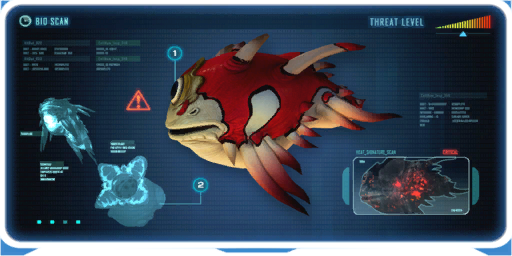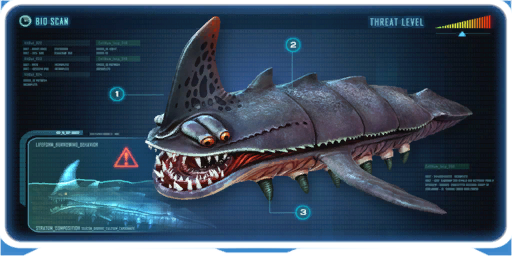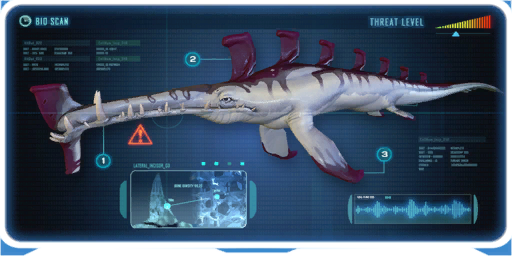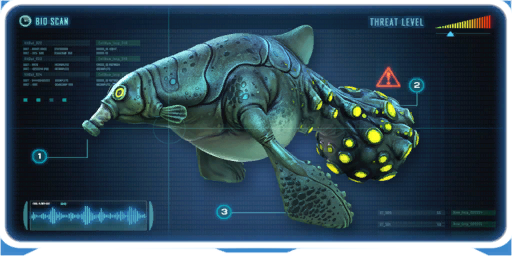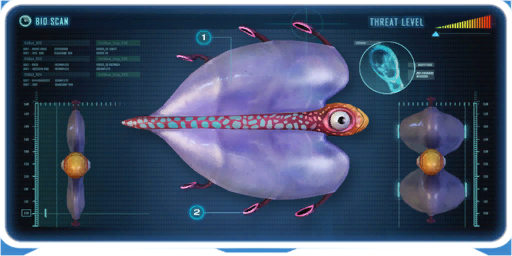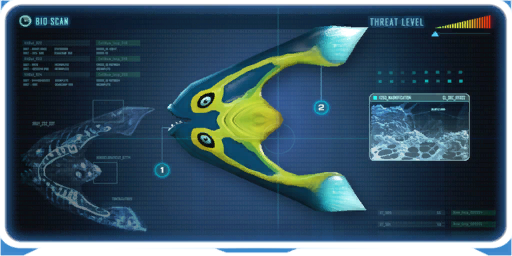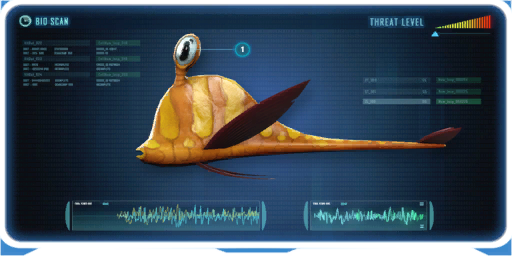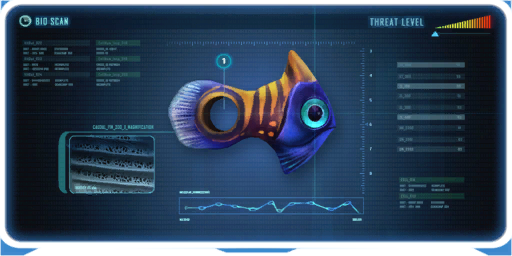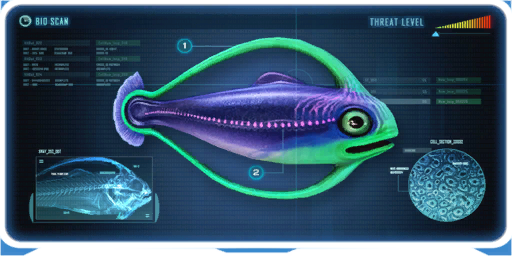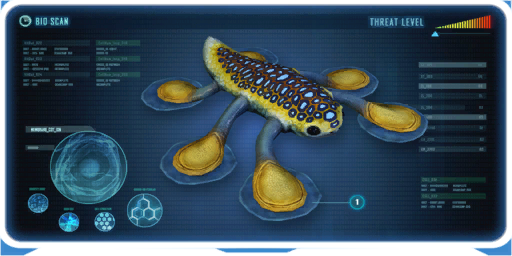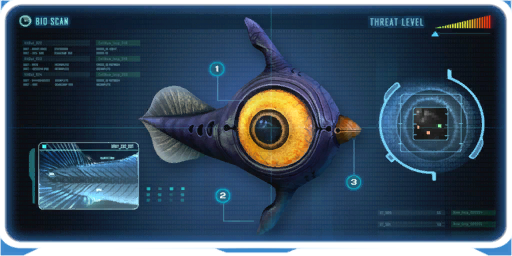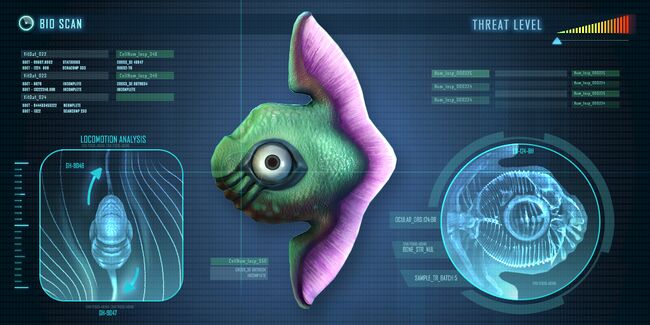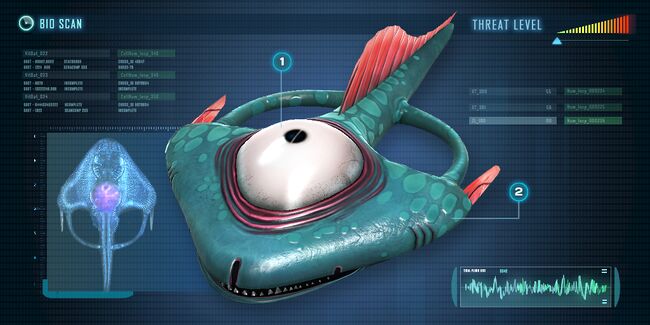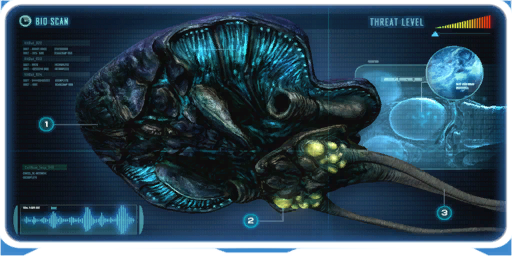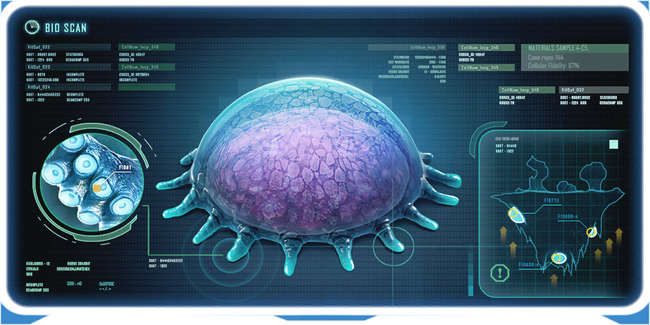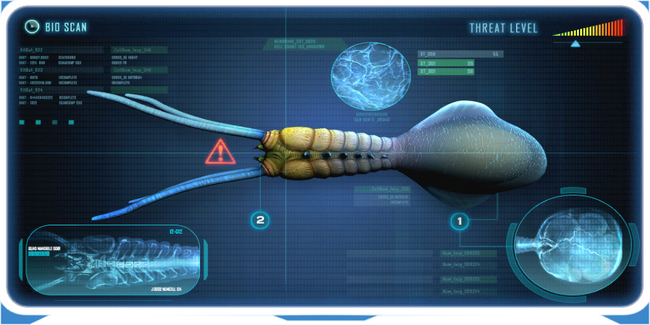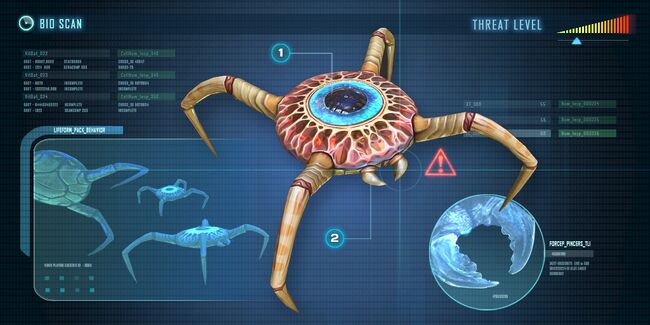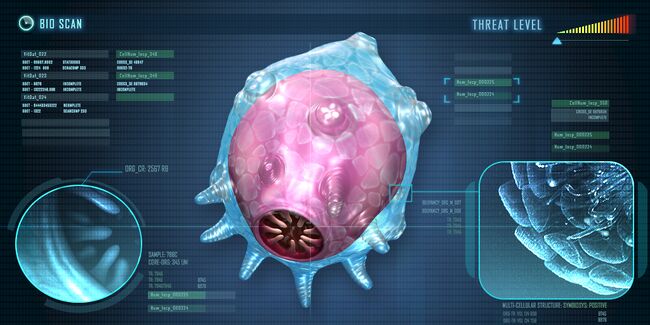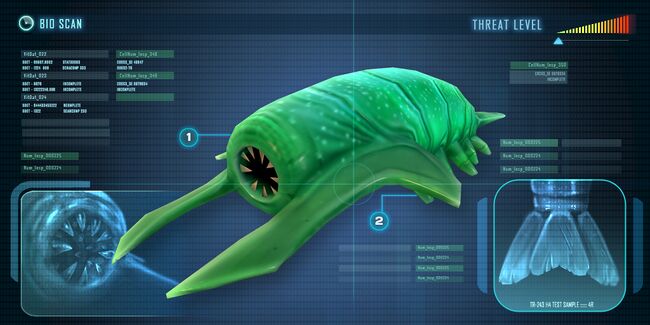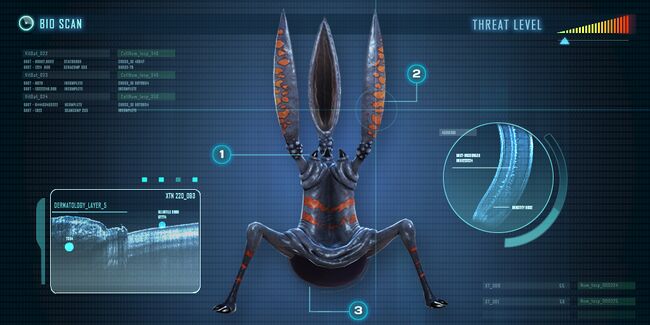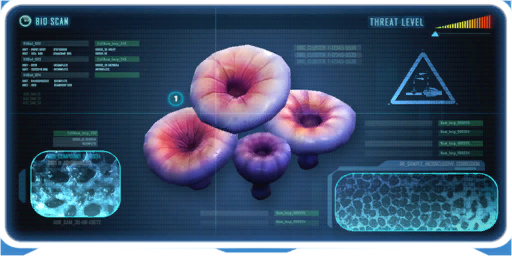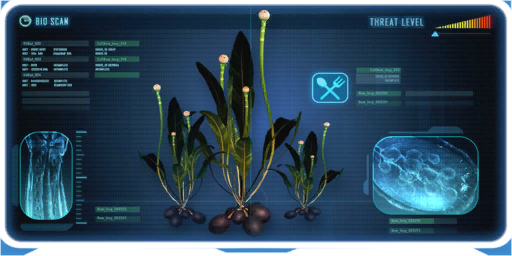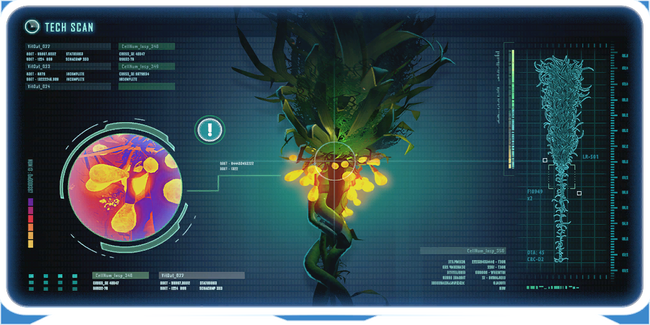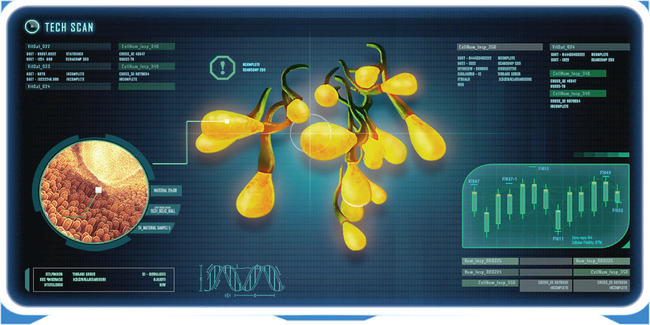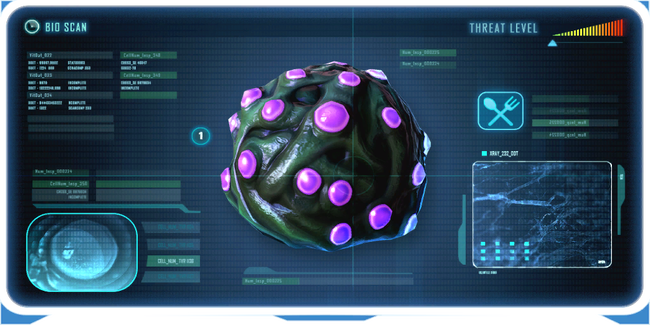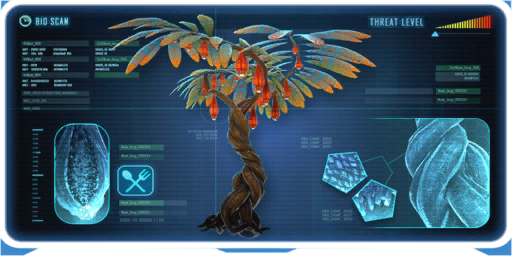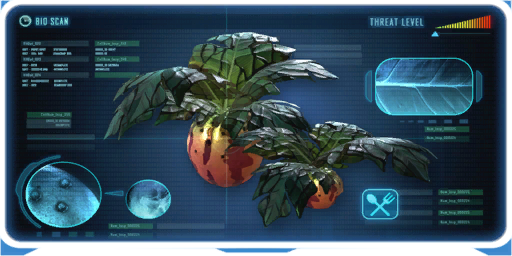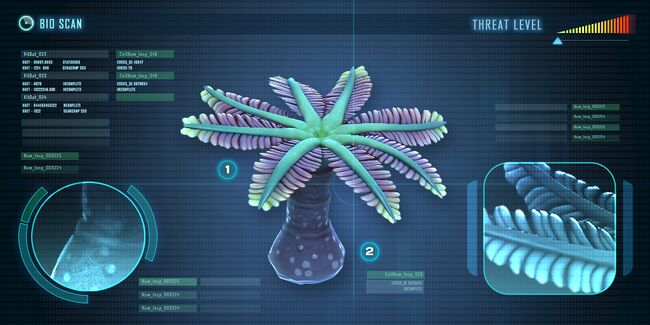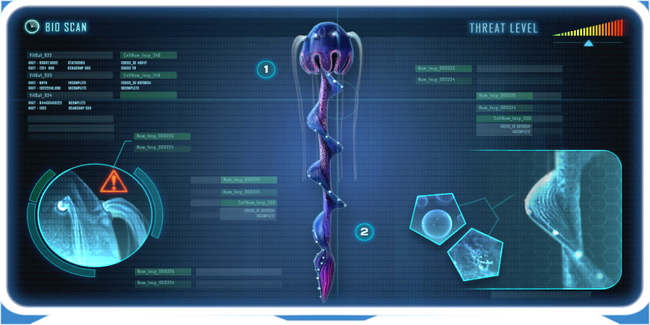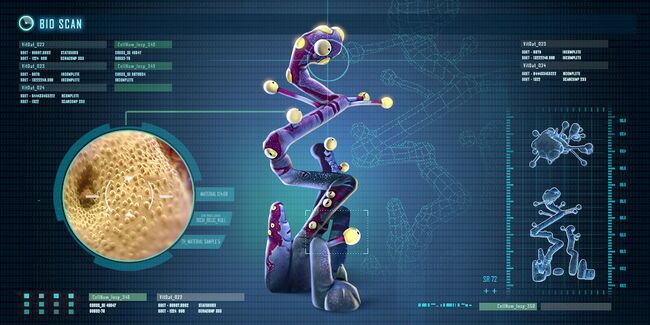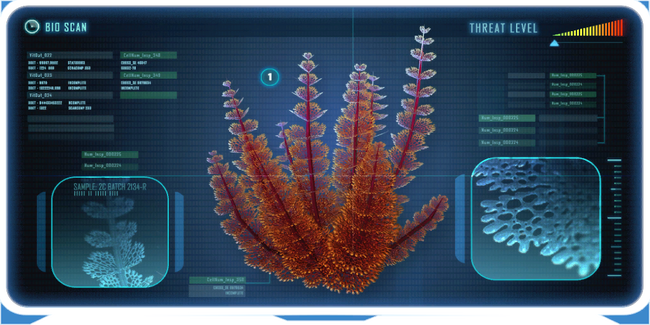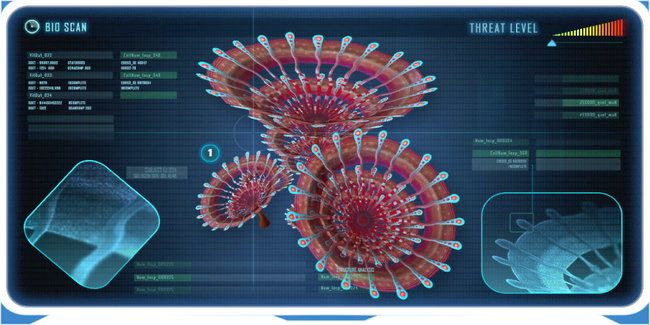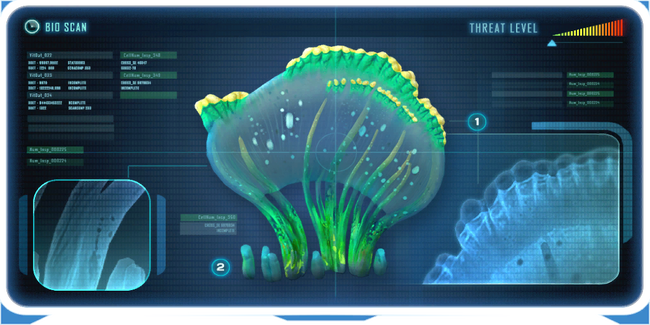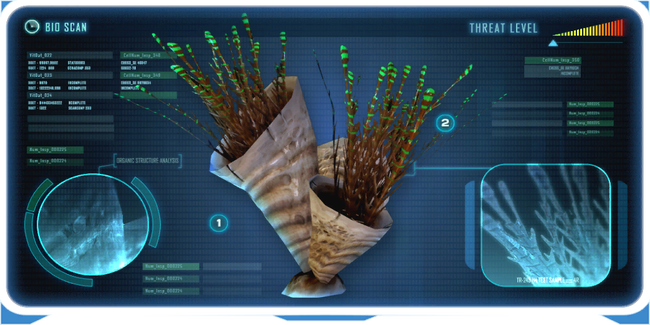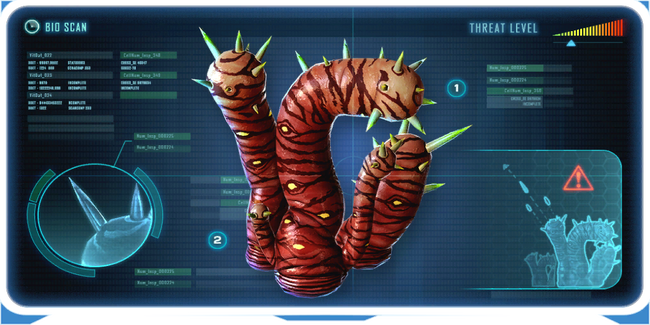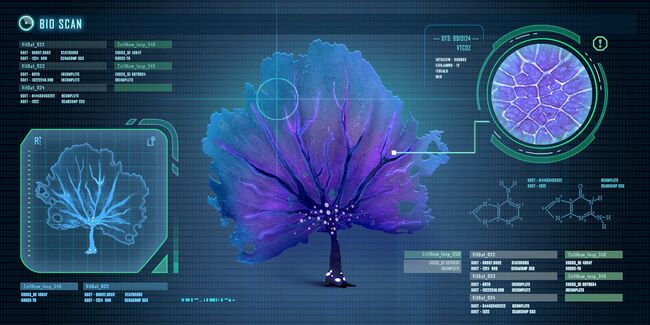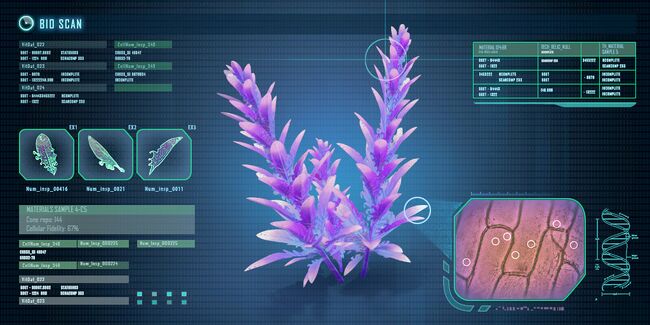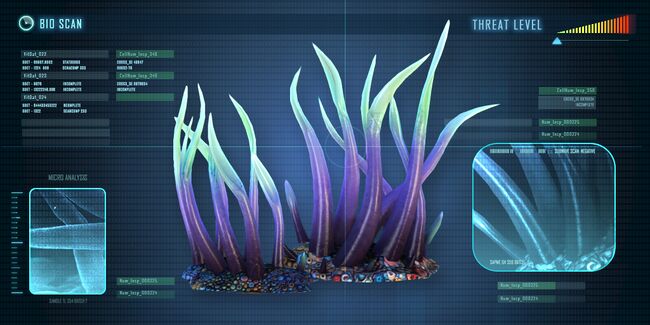Databank (Subnautica): Difference between revisions
m (→Alien Eggs) |
|||
| Line 9: | Line 9: | ||
|image= |
|image= |
||
|description= |
|description= |
||
<font style="display: none">This breaks without the invisible font. Don't ask.</font> |
|||
Evidence suggests that a substantial number, if not all of the local species reproduce through egg-laying. Eggs can be found resting on the seafloor, buried beneath detritus, or even wedged into cracks in the rock. |
Evidence suggests that a substantial number, if not all of the local species reproduce through egg-laying. Eggs can be found resting on the seafloor, buried beneath detritus, or even wedged into cracks in the rock. |
||
| Line 33: | Line 34: | ||
|source=[[Scanner|Scan]] [[Kharaa Bacterium|Infected]] [[Fauna]] |
|source=[[Scanner|Scan]] [[Kharaa Bacterium|Infected]] [[Fauna]] |
||
}} |
}} |
||
==Blueprints== |
==Blueprints== |
||
Revision as of 17:41, 16 February 2019

|
Read at own risk This article contains unmarked spoilers. Players new to the game would want to avoid or be cautious toward this article. |
The Databank is the encyclopedia of entries that are visible on the encyclopedia of the PDA.
Advanced Theories
Alien Eggs
| Alien Eggs |
| <poem>This breaks without the invisible font. Don't ask.
Evidence suggests that a substantial number, if not all of the local species reproduce through egg-laying. Eggs can be found resting on the seafloor, buried beneath detritus, or even wedged into cracks in the rock. Different species likely favor different biomes as their nesting grounds. Eggs discovered in the wild are in some form of natural stasis, likely awaiting ideal conditions in which to hatch, or the delivery of some vital enzyme which will kick start the process. It is impossible to calculate the species of the egg from the exterior, however it may be possible to stimulate a hatching response if an egg is relocated to a suitable alien containment unit.</poem> |
| Source: Pick up Alien Egg |
| Specimen with Symptoms of Infection |
| <poem>This organism is displaying signs of a bacterial infection.
- Bright green blisters are forming networks around the infection sites WARNING: May be contagious. Avoid. Do not under any circumstances consume the flesh.</poem> |
| Source: Scan Infected Fauna |
Blueprints
Equipment
| Air Pumps |
| <poem>Air pumps can be used to pipe breathable air to a remote location.
- The base-attached airpump can be built at a compatible habitat, and will source oxygen directly from the habitat's oxygen generator |
| Source: Unlocked by default |
| Creature Decoy |
| <poem>This advanced deployable is a catch-all solution for mimicking the behavior of a living creature, for purposes of scientific research or predator evasion.
- Vibrates, cycles air and water, and sends out randomized, high-frequency sound waves to emulate a living organism |
| Source: Unlock Creature Decoy Blueprint |
| Handheld Scanner |
| <poem>The essential science and survival tool, the scanner can be used to add new blueprints to memory, and analyze unknown entities.
It emits electromagnetic radiation in the specified direction, which is reflected by the environment and then analyzed to determine the physical make-up of the targeted object. It has four primary functions. Blueprint Adquisition: Organism Analysis: Medical Analysis: Self-Scan: 'The Alterra Spectroscope Scanner - Understanding the world so you don't have to.'</poem> |
| Source: Unlocked by default |
| Light Stick |
| <poem>A mobile, battery-powered LED light, which provides low-level lighting in a 360 degree area, and can be attached to most surfaces.</poem> |
| Source: Scan Light Stick Fragments |
| Propulsion Cannon |
| <poem>The propulsion cannon allows technicians to manipulate gravitational forces at ranges of up to 20m. It is commonly used in construction and mining to move materials.
Operating Instructions: 'The Prop Cannon: Some species are telekinetic. For everyone else, there's Alterra.'</poem> |
| Source: Scan Propulsion Cannon Fragments |
| Radiation Suit |
| <poem>This suit fully protects against the effects of radiation during land, sea and space exploration.
- Safety rated up to 400 Sv/hr 'The Radiation Suit: A necessary precaution in a post-MAD world.'</poem> |
| Source: Unlock Radiation Suit Blueprint |
| Reinforced Dive Suit |
| <poem>This suit is reinforced with synthetic fibers to reduce incoming physical and thermal damage.
- Shock absorption reduces physical impact velocity by approximately 50% 'The Reinforced Dive Suit: Why take chances, when you can take Alterra?'</poem> |
| Source: Unlock Reinforced Dive Suit Blueprint |
| Repair Tool |
| <poem>The repair tool can be targeted at any common device - control panels, habitat modules, radios etc. - to stitch wires and seams back together at the atomic level. All good technicians keep one of these under their pillow.
Most people don't care why it works, just that it saved their life that one time - but in case you're curious, it combines scanner and fabricator technologies to determine the proper specifications for the targeted object, and then rearranges the available physical material to match the original specs. 'The Alterra Repair Tool: Get your fix.'</poem> |
| Source: Unlocked by default |
| Time Capsule |
| <poem>These sturdy containers are designed to store written and photographic evidence for later retrieval, in addition to a number of small items. Time capsules are often fabricated by marooned survivors seeking either to aid those who find themselves in the same predicament in the future, or to leave evidence of their plight which may be found long after their bodies have disintegrated.
Most emergency escape vehicles are equipped with a time capsule by default, usually found in the cockpit, and be jettisoned on take off. Alterra requests time capsules be stocked with tools and resources which will aid those who may discover them in the future.</poem> |
| Source: Scan Time Capsule |
Habitat Instalation
| Aquarium |
| <poem>The aquarium is designed to hold and sustain up to eight small aquatic organisms, and fits inside a regular multipurpose habitat room.
Aquatic creatures make up 70% of all known species, making the aquarium a commonly deployed tool in many exploratory operations. It is just as often used to house livestock for later consumption as it is to hold specimens for xeno research. An automated environment regulation system means there's no need to feed or care for your subjects. NB Due to its size the regular aquarium is not rated for breeding applications, and creatures are highly unlikely to mate. Construct a full size alien containment unit for this purpose.</poem> |
| Source: Unlocked by default |
| Bulkhead Door |
| <poem>The bulkhead door is designed to separate compartments while reinforcing structural integrity with its solid titanium frame. The door can be opened and closed to seal off compartments in the event of fire or flooding, or simply for privacy.</poem> |
| Source: Scan Bulkhead |
| Exterior Growbed |
| <poem>Advanced synthetic soils allow this growbed to support a huge variety and quantity of alien plant life, and it can be installed anywhere on land or underwater where there is space.</poem> |
| Source: Scan Exterior Growbed |
| Fabricator |
| <poem>Fabrication technology is the power to rearrange matter at the atomic level. It was the catalyst behind the great expansion, and remains the backbone of the modern world.
Fabricators come in all shapes and sizes, but the most common are small enough to be wall-mounted, and are used for everything from constructing everyday implements to cooking dinner. It is common today for households to keep a store of generic base materials on hand for any eventuality.</poem> |
| Source: Unlocked by default |
| Floodlight |
| <poem>The standard issue floodlight is designed to focus a bright beam of light in a single direction, useful in all kinds of industrial and emergency operations. Functions in all known environments.</poem> |
| Source: Scan Floodlight |
| Habitat Builder |
| <poem>The Alterra handheld habitat builder has been an essential tool of xenoscientists, colonists and emergency relief crews across 11 different trans-govs for more than 50 years.
- Habitat modules are hermetically sealed from the outside environment Quick Start Guide: Primary habitat systems like oxygen generation and flood control, as well as modules like the fabricator draw power and will not function without it. Additional compartments reduce overall hull integrity, depending on the external pressure. 'Quick-Build Habitats: A home far, far away from home.'</poem> |
| Source: Unlocked by default |
| Interior Growbed |
| <poem>Designed for use exclusively inside regulated habitat modules, the interior growbed is more compact than the outdoor version, and features a hydroponic nutrient delivery system.</poem> |
| Source: Scan Interior Growbed |
| Modification Station |
| <poem>Where the standard fabricator atomically rearranges raw materials to form complex devices, the mod station is able to combine complex devices to enhance their function. Most industrial vessels are fitted with a complement of equipment modification stations, which enable engineers to adapt their tools on the fly.
To conserve hard drive space the modification station is excluded by default from most personal emergency blueprint libraries; however extreme environments such as ocean and desert class planets may necessitate the adaptation of basic survival tools for unanticipated applications. For this reason access to a mod station is always recommended.</poem> |
| Source: Scan Modification Station Fragments |
| Moonpool |
| <poem>The moonpool is an essential module for long-term exploration. Its primary function is as a dry dock for small vehicles such as the Seamoth and Prawn suit.
The large central chamber contains a pressurized pool which provides ready access to the surrounding waters, and comes as standard with equipment for raising and recharging a vehicle. When outfitted with a vehicle modification station the moonpool can be used to build and equip vehicle upgrades. Ratings:
- Dimensions: 16m x 10m x 5m |
| Source: Scan Moonpool Fragments |
| Planter & Pots |
| <poem>Interior planters come in a variety of configurations, and allow for most plant species to be grown in small numbers. For decorative or botanical use.</poem> |
| Source: Scan Plant Pots |
| Scanner Room |
| <poem>This advanced habitat module can transform a small outpost into a burgeoning science and exploration station.
- A 3D display in the center of the room stores local topographical data |
| Source: Scan Scanner Room Fragments |
| Solar Panel |
| <poem>Solar power is the most prevalent power source in the galaxy, and so it is no accident that the standard solar panel is the default means of powering a habitat. A power source is a requirement of habitat oxygen generators and other onboard modules.
- Provides limited power for small outposts and survival habitats |
| Source: Unlocked by default |
| Spotlight |
| <poem>A permanent lighting solution developed for installation on existing habitats and facilities.
- Automatically rotates on a 180 degree arch |
| Source: Scan Spotlight |
Power
| Bioreactor |
| <poem>On planets where organic matter is plentiful but sunlight is not, a reliable bioreactor will frequently prove the most efficient power solution.
- May be installed in any multipurpose habitat room 'The Bioreactor: Totally organic.'</poem> |
| Source: Scan Bioreactor Fragments |
| Thermal Plant |
| <poem>The first rule of survival in hostile environments is to work with the resources available. If it's 800 degrees outside and you're in danger of burning to death at any moment you may as well get some cheap, reliable energy out of it.
- Converts heat energy into electricity 'The Thermal Power Plant: It's hot'.</poem> |
| Source: Scan Thermal Plant Fragments |
Vehicles
| Cyclops |
| <poem>The cyclops is the most popular and reliable deep-sea submersible in the galaxy. By comparison to the competition it can be crewed by just one pilot, hence the name.
It features: Advice for Captains: Ratings: NB The cyclops does NOT feature: |
| Source: Scan Cyclops Fragments |
| Mobile Vehicle Bay |
| <poem>The mobile vehicle bay is a deployable station equipped with fabrication drones, designed to construct small research and exploration vehicles from raw materials. It is a common tool in almost all industrial, scientific and colonization operations.</poem> |
| Source: Unlocked by default |
| Prawn Suit (Mk.III) |
| <poem>The Pressure Re-Active Waterproof Nano Suit is a range of mechs designed to protect the pilot from extreme environments. The Mk.III is the latest iteration, and has so far only been rolled out by Alterra for their own high-value, phasegate-related operations.
- The suit is fully insulated from the outside environment 'The Prawn Suit: It's got you covered.'</poem> |
| Source: Scan Prawn Suit Fragments |
| Seaglide |
| <poem>The seaglide is a personal transportation device designed for use in oceanic environments.
- Capable of speeds of up to 36km/h in standing water 'The Seaglide: Anything that moves faster underwater is probably trying to eat you.'</poem> |
| Source: Scan Seaglide Fragments |
| Seamoth |
| <poem>The seamoth is a one-person vehicle with an independent, replaceable power cell fitted in the rear and a fully customizable design. Low power, multi-directional thrusters enable it to function equally well in sea or space environments.
Most long-range vessels carry at least two vehicles of this class to facilitate the exploration and exploitation of small astronomical bodies, however they can also be fabricated at a standard mobile vehicle bay. Ratings: Seamoths may be modified by installing upgrade modules to the access point mounted on the wing. These include: NB These modules may only be manufactured at a moonpool outfitted with a vehicle modification station. 'The Seamoth: It goes anywhere but land.'</poem> |
| Source: Scan Seamoth Fragments |
| Vehicle Upgrade Console |
| <poem>This terminal allows vehicles to be customized with different naming and color schemes, and upgrade modules.
- Must be installed in a compatible moonpool module |
| Source: Unlock Vehicle Upgrade Console Blueprint |
Geological Data
| 4546B Environment Scan |
| <poem>This breaks without the invisible font. Don't ask.
- Category 3 Ocean planet Safety Warnings: It is not recommended to explore this environment without hazardous material suits and extensive support apparatus.</poem> |
| Source: Repair Lifepod 5 |
| Limestone Outcrops |
| <poem>These unusual geological structures often form around titanium and copper deposits, and are distinct to this planet. Closer analysis reveals the stone around the metal has been hardened against erosion, but the mechanism remains unknown.
Assessment: Titanium and copper source</poem> |
| Source: Scan Limestone Outcrop |
| Ruby |
| <poem>A hard, blood-red gemstone, made of aluminum oxide. Rubies may be processed in order to leverage their structural integrity in advanced vehicle construction and modification.
Assessment: Essential for advanced fabrication</poem> |
| Source: Scan Ruby |
| Sandstone Outcrops |
| <poem>These common, porous outcrops seem to form around small amounts of precious metals, or otherwise these metals are part of a sedimentary buildup over time.
Assessment: Lead, silver and gold source</poem> |
| Source: Scan Sandstone Outcrop |
| Shale Outcrops |
| <poem>This sedimentary rock is formed from flakes of clay minerals, inside of which rare metals such as lithium can be found. Geological conditions on this planet mean it tends to be found in deeper biomes.
Assessment: Gold, lithium and diamond source</poem> |
| Source: Scan Shale Outcrop |
| Scattered Wreckage |
| <poem>Analysis confirms this wreckage is from the Aurora.
Outer layers of the material have oxidized, suggesting it has been heated to over 1200 Celsius. This pattern is consistent with hull disintegration during atmospheric entry. Salvage of intact portions of Alterra vessels is prohibited at legal, moral and technical levels, however scraps such as these may be reclaimed for their titanium content at any Alterra fabricator.</poem> |
| Source: Scan Metal Salvage |
Indigenous Lifeforms
Coral
| Brain Coral |
| <poem>A permanent, growing colony of microscopic organisms. This coral species has adapted to filter carbon dioxide from the environment, using the carbon to build the colony, and expelling the oxygen from specialized exhaust funnels. It is quite hardy, suggesting samples from a mature specimen could be grown artificially.
Assessment: Air tanks are equipped to siphon oxygen from the water where possible</poem> |
| Source: Scan Brain Coral |
| Coral Shell Plate |
| <poem>This variant of coral has adapted to survive in close proximity to other corals, filtering nutrients from the water and sharing them via a spore-like substance which grows around the base.
Assessment: No practical applications discovered</poem> |
| Source: Scan Coral Shell Plate |
| Giant Coral Tubes |
| <poem>The variety of coral formations on 4546B appear to be different solutions to the same problem of maximizing water and nutrient flow throughout the colony. These particular variants funnel water down a tube, filtering nutrients as they pass. Their size suggests they have been highly successful.
Assessment: Coral tube samples are rich in calcium, exploitable in bleach fabrication</poem> |
| Source: Scan Giant Coral Tubes |
| Table Coral |
| <poem>Each disk is an individual colony of microorganisms, filtering nutrients from the water.
Growth patterns indicate the colonies are in direct competition for positions with superior current or light. Unlike other coral species its structure is malleable, softly pulsating as it pumps nutrients to its extremities, and only turning rigid when it senses physical assault. The jewel-like nodes in the surface are concentrated build-ups of rare minerals the coral is unable to process. Assessment: Exploitable in computer chip fabrication</poem> |
| Source: Scan Table Coral |
Fauna
Carnivores
| Biter |
| <poem>Vicious, pack-hunting predator. 94% muscle, 4% connective tissue, 2% brain. Indiscriminate when hungry. Almost always hungry.
1. Specialized Olfactory Antenna: 2. Secondary Pair of Eyes: 3. Overdeveloped Tail Fin: Assessment: Avoid packs - Try not to bleed</poem> |
| Source: Scan Biter |
| Crashfish |
| <poem>This unusual species has developed an emergency defense mechanism based on mutually assured destruction.
1. Forward-mounted Eye: 2. Sulfur Plant: 3. Defense Mechanism: Assessment: Equip stasis rifle, repulsion cannon or similar before approaching shallow caves</poem> |
| Source: Scan Crashfish |
| Mesmer |
| <poem>Small, carnivorous lifeform with a unique hunting mechanism that enables it to hypnotize its foes.
1. Outer Wings: 2. Outer Shell: Assessment: Draw closer</poem> |
| Source: Scan Mesmer |
| Sand Shark |
| <poem>A powerful, medium-sized predator that burrows into the sand and ambushes its prey from below. As with many predators it may be possible to temporarily distract sand sharks by feeding any hungry specimens that draw close.
1. Forward Dorsal Fin: 2. Segmented Exoskeleton: 3. Feet: Assessment: Avoid - Be vigilant for ambush in sandy biomes</poem> |
| Source: Scan Sand Shark |
| Stalker |
| <poem>A streamlined predator encountered in the kelp forests in wait of prey leaving the safety of the shallows to feed. The stalker likely carved out its evolutionary niche at the sweet spot between speed and size millions of years ago, and may be one of the oldest species on the planet.
The stalker appears to be attracted to titanium deposits, which tends to sharpen and put stress on its teeth. As with many predators, it may be possible to temporarily distract hungry stalkers by feeding them. 1. Teeth: 2. Night-vision: 3. Dorsal Ridges: 4. Pelvic Fins: Assessment: Stalker teeth may have applications in enameled glass fabrication</poem> |
| Source: Scan Stalker |
| Stalker Teeth |
| <poem>Extended analysis of acquired dental samples has been completed. Samples matched to species designated 'stalker'.
Stalker teeth exhibit extraordinary lightness and strength, and contain only trace amounts of calcium. The edges show signs of wear, and are studded with metal flakes, providing evidence that the stalkers chew on metal deposits in order to sharpen their teeth. Assessment: Applications as a natural substrate in enameled glass fabrication</poem> |
| Source: Scan Stalker Teeth |
Herbivores - Large
| Gasopod |
| <poem>A slow-moving lifeform, and one of the larger herbivores on the planet. Providing a substantial meal to would-be predators, the gasopod protects its domain by filling the surrounding water with poisonous and corrosive pods whose contents dissolve even synthetic fibers.
1. Filtration System: 2. Algae Gland: 3. Large Pelvic Fins: 4. Behavior: Assessment: Approach with caution - Acidic pods may be retrieved and re-purposed</poem> |
| Source: Scan Gasopod |
| Rabbit Ray |
| <poem>A herbivorous aquatic lifeform, rabbit rays appear to live serene and solitary lives, with few predators, a natural sense of curiosity and awesomely poisonous flesh.
1. Ears: 2. Undulating Wings: Evidence indicates its large, side-facing eyes are relatively recent adaptations. It is likely there are related ray species in other environmental biomes on the planet. Assessment: Inedible but harmless</poem> |
| Source: Scan Rabbit Ray |
Herbivores - Small
| Bladderfish |
| <poem>This unusual herbivore appears to be mostly defenseless, and bears little resemblance to the other lifeforms around it.
1. Semi-permeable Bladder: 2. Open-ended Vascular Tubing: Largely oblivious to threats, and practically immobile at night, its only identified defense mechanism is that it's composed almost entirely of water, air and cartilage. Assessment: Edible (oxygen may be retrieved from the bladder and added to tanks on consumption); membrane has applications as a natural water filter</poem> |
| Source: Scan Bladderfish |
| Boomerang |
| <poem>A herbivore encountered in large numbers, found to frequent shallow waters and move in schools.
1. Serrated Teeth: 2. Twin-fins: Most active during daylight hours, and prone to flee on approach, the boomerang can more easily be observed at night when its luminescence gives it away and it seeks the shelter of the seabed. Assessment: Edible</poem> |
| Source: Scan Boomerang |
| Garryfish |
| <poem>Slow-moving and curious herbivore, camouflage indicates adaptation for evasive behavior on the ocean floor.
1. Eye Stalks: 2. Behavior: Assessment: Edible</poem> |
| Source: Scan Garryfish |
| Holefish |
| <poem>A very small herbivore found in low numbers, often around cave system entrances where their skin coloration blends into the background.
1. Bored-out Tail Fin: 2. Size: Assessment: Edible</poem> |
| Source: Scan Holefish |
| Hoopfish |
| <poem>Small, school-mentality prey fish with a unique method of propulsion, and a distant relative of the bladderfish.
1. Antennae: 2. Purple/Green Coloration: 3. Behavior: Assessment: Edible</poem> |
| Source: Scan Hoopfish |
| Hoverfish |
| <poem>A small, cautious herbivore, commonly found in kelp-rich environments.
1. Charged Footpads: Assessment: Edible</poem> |
| Source: Scan Hoverfish |
| Peeper |
| <poem>A fast prey fish encountered in shallow waters and rich in protein.
1. Developed, Side-facing Eyes: 2. Powerful Fins: 3. Beak: 4. Expulsion Tubes: While the peeper is well adapted to survive in shallow waters, a number of its features serve no discernible purpose. It would appear to be just as well suited to survive in deeper waters, and is somewhat more intelligent than the usual small herbivore. Assessment: Edible (high calorie count), further research required</poem> |
| Source: Scan Peeper |
| Reginald |
| <poem>A small herbivore, and a distant relative of the common peeper, sharing that species' well-developed, side-facing eyes; approximate size; and body profile.
1. Coloration: 2. Diet: Assessment: Edible (high calorie count)</poem> |
| Source: Scan Reginald |
| Spadefish |
| <poem>A medium-sized herbivore found in deeper waters.
1. Single Eye: 2. Mottled-green Coloration: 3. Behavior: Assessment: Edible</poem> |
| Source: Scan Spadefish |
Leviathans
| Reefback Leviathan |
| <poem>This vast lifeform is in excess of 30m long and has been designated leviathan class. Fortunately it feeds exclusively on plankton-like lifeforms in the water.
1. Chitinous Shell: 2. Enzyme Pods: 3. Local Microcosm: 4. Lifecycle: Assessment: Harbors plants, small fish and metal-rich barnacles</poem> |
| Source: Scan Reefback Leviathan |
Scavengers & Parasites
| Ancient Floater |
| <poem>Biodata suggests these vast floaters have matured in an ingenious symbiosis with the land they have attached to.
- The attached landmass is raised in the water, increasing sunlight and encouraging plantgrowth Lifecycle: In extreme circumstances a number of floaters may attach to a leviathan class lifeform, forcing it to the surface and effectively asphyxiating it. The body will be consumed over a number of months until eventually dissolving, leaving the floaters free to attach to a new host. Those creatures which successfully raise a landmass to the surface are rewarded with a burgeoning and permanent food supply, allowing them finally to reproduce and begin the cycle again. Assessment: Incredible</poem> |
| Source: Scan Ancient Floater |
| Bleeder |
| <poem>A simple parasitic organism, little more complex than the common space tick, but just as dirty.
1. Ductile Sack: 2. Jaw: 3. Behavior: Assessment: Inconvenient and unhygienic - Avoid or incapacitate</poem> |
| Source: Scan Bleeder |
| Cave Crawler |
| <poem>Agile, territorial carrion-feeder. Well-adapted to both land and sea.
1. Gas Exchange Membrane: 2. Mandibles: Assessment: Necessary waste recycler - Avoid or incapacitate</poem> |
| Source: Scan Cave Crawler |
| Floater |
| <poem>Two species living in symbiosis, which attach to and attempt to feed on any objects they come into contact with.
1. Dominant Lifeform: 2. Microorganism Membrane: 3. Helium Buffer: Assessment: May aid in flotation of sunken objects</poem> |
| Source: Scan Floater |
| Rockgrub |
| <poem>A small, luminescent scavenger, roughly thumb-sized. This creature may be a distant relative of the sand shark, sharing that species' unusual limbs, segmented exoskeleton and burrowing behavior.
1. Jaw: 2. Limbs: 3. Green Luminescence: Assessment: Harmless</poem> |
| Source: Scan Rockgrub |
| Shuttlebug |
| <poem>A common scavenger at the base of the food chain.
1. Mouth Parts: 2. Three Mandibles: 3. Three Legs: Assessment: Necessary waste recycler - Presence may indicate nearby cave systems</poem> |
| Source: Scan Shuttlebug |
Flora
Exploitable
| Acid Mushroom |
| <poem>A common, spore-bearing fungi species. The flesh contains a highly acidic compound which leaches into the water if the outer skin is penetrated.
It is not clear which predator species necessitated such extreme counter-measures, but the acid mushroom's numbers suggest it has successfully deterred most of them. Assessment: Inedible - Acid has applications in battery fabrication</poem> |
| Source: Scan Acid Mushroom |
| Bulbo Tree |
| <poem>A bulb-based flora which roots to the ground and sprouts turquoise leaves. Analysis suggests the sap produced by this plant is poisonous to insects, but can be harvested and consumed by humans for its high water-content.
Assessment: Edible, high water content</poem> |
| Source: Scan Bulbo Tree |
| Chinese Potato Plant |
| <poem>The Chinese potato is common throughout the China Territories, where synthetic foods are still stigmatized, and there remain large tracts of arable land on which to grow fresh produce. Genetically designed prior to the Expansion, this plant is highly adaptable to different environments, and a staple of new colonies galaxy-wide.
Assessment: Edible</poem> |
| Source: Scan Chinese Potato Plant |
| Creepvine |
| <poem>A kelp species concentrated in large forests, in shallow, sandy waters. Loose roots anchor the plant to the sea floor, from where it grows steadily toward the surface in pursuit of sunlight.
The stem is fibrous and rich in iron, making it both a viable base material for fabrication of textiles, as well as a basic foodstuff. Assessment: Vital alien resource - Edible - Construction Applications</poem> |
| Source: Scan Creepvine |
| Creepvine Seeds |
| <poem>Mature creepvine plants that have survived the predation of small herbivores produce these bioluminescent seed clusters, which may be knocked loose by currents or consumed and later deposited by predators.
The embryo is surrounded by a thick oil and silicone layer, which would disperse into the ground as the outer skin deteriorated. This may provide the seedling with the nutrients it needs to survive the low-light conditions on the sea bed. Assessment: Vital alien resource - Construction Applications</poem> |
| Source: Scan Creepvine Seed Cluster |
| Gel Sack |
| <poem>These organic structures grow on cave walls. The purple sacks which arise from the surface contain a low-density gel laced with spores. These burst from time to time, floating towards the surface and attaching onto the next rock face they encounter.
While the gel sack is edible, its low-density renders it an invaluable advanced construction material. Assessment: Edible - Aerogel construction applications</poem> |
| Source: Scan Gel Sack |
| Lantern Tree |
| <poem>A conglomeration of individual vines which rely on one another for structural support. Grows exclusively on fertile land. Each vine produces orange, lantern-shaped fruits with minimal nutrition and hydration value.
Assessment: Edible in an emergency</poem> |
| Source: Scan Lantern Tree |
| Marblemelon Plant |
| <poem>This plant collects water from the air rather than relying on its root system, and produces large, fleshy fruits which are both edible, and have atypically high water content.
Assessment: Edible - High water content</poem> |
| Source: Scan Marblemelon Plant |
| Sulfur Plant |
| <poem>These plants appear to serve as nests for the explosive organisms which guard them.
- The outer petals are undamaged by the presence of the inhabiting creature, suggesting a complex co-development Assessment: Sulfur has applications in construction of the repair tool</poem> |
| Source: Scan Sulfur Plant |
Sea
| Blue Palm |
| <poem>The blue palm is a common aquatic plant which thrives in shallower waters with high exposure to sunlight. Long fronds intercept light before it can reach the smaller flora on the seabed.</poem> |
| Source: Scan Blue Palm |
| Drooping Stingers |
| <poem>1. Zero photosynthetic cells detected. Implies carnivorous adaptation to low-light environments.
2. Follicles along the tentacles are capable of detecting contact with foreign bodies, triggering an electromagnetic charge in the 600 watt range. Prey is likely paralyzed and consumed over many weeks. Prey: Small fish Assessment: Avoid</poem> |
| Source: Scan Drooping Stingers |
| Eye Stalk |
| <poem>A cave-dwelling tuber dotted with luminescent, photosensitive 'eyes'. These eyes may in some way direct the twisted growth of the stems themselves, possibly in reaction to other light sources, proximity of cave walls, or other environmental conditions.</poem> |
| Source: Scan Eye Stalk |
| Furled Papyrus |
| <poem>The function of the distinctive curled leaves on this aquatic plant is not immediately clear. It is possible the leaves unfurl in low-light conditions, or that they are designed to channel water currents through the main body of the plant, thus enhancing nutrient take-up.</poem> |
| Source: Scan Furled Papyrus |
| Jellyshroom |
| <poem>A lifeform unique to a microcosm located in a cave system deep within the grassy plateaus, where a high concentration of carnivorous lifeforms wards off smaller predators.
- Consists of a tough, trunk-like base from which grows a fragile purple membrane Predators: None identified</poem> |
| Source: Scan Jellyshroom |
| Redwort |
| <poem>A common plant adaptable to many different environments, the redwort is a staple part of the diet of many smaller herbivores.</poem> |
| Source: Scan Redwort |
| Regress Shell |
| <poem>This specimen is composed of a complex series of regressing rings, connected by tendrils.</poem> |
| Source: Scan Regress Shell |
| Sea Crown |
| <poem>This plant consists primarily of a large bladder-like sack containing a huge variety of bacterial species, which may enable it to break down complex compounds it draws from the root system. Shares large sections of genetic code with the membrain tree. Environment scans indicate this plant is rare to the point of extinction.</poem> |
| Source: Scan Sea Crown |
| Spiked Horn Grass |
| <poem>While it shares a closes genetic similarity with blood grass, this species has evolved to house its root system in rigid, horn-shaped enclosures.</poem> |
| Source: Scan Spiked Horn Grass |
| Tiger Plant |
| <poem>This plant has adapted to sense fluctuations in the water at up to 15m, and is capable both of prehensile movement of its tubes, as well as the propelling of thorns at speeds of up to 10m/s.
Although capable of incapacitating small herbivores, this plant lacks carnivorous digestive organs. Would-be predators caught in its defensive perimeter serve as a warning to other herbivores not to approach; and then as they decompose they serve as fertilizer for the tiger plant. Assessment: Avoid or incapacitate</poem> |
| Source: Scan Tiger Plant |
| Veined Nettle |
| <poem>A common, shallow-water plant which frequently shows signs of predation around the edges of the leaves. Thick, violet veins carry nutrients to the extremities of the fan, and brightly-colored seeds grow around the base and stem.</poem> |
| Source: Scan Veined Nettle |
| Violet Beau |
| <poem>A common, luminescent plant which grows in patches on the seabed.</poem> |
| Source: Scan Violet Beau |
| Writhing Weed |
| <poem>Well-adapted to both shallow waters and cave systems, this plant lives in symbiosis with a coral species which forms around the base of the stems.</poem> |
| Source: Scan Writhing Weed |

